
San Francisco - The American Veterinary Society of Animal Behavior (AVSAB) urges specialists and general practitioners to drop punishment as a first-line treatment to modify a pet's behavior.

San Francisco - The American Veterinary Society of Animal Behavior (AVSAB) urges specialists and general practitioners to drop punishment as a first-line treatment to modify a pet's behavior.

Puppies can play rough. So to ensure a lifetime of safe and happy interactions, learn how to play appropriately with your new puppy from the start.

San Francisco - 12/12/07 - The American Veterinary Society of Animal Behavior (AVSAB) released a position statement and guidelines last month titled "Use of punishment for dealing with behavior problems in animals."

Many owners begin their relationship with new puppies armed with misinformation and an idealistic view of the pet-owner relationship. Owners often don't know how to properly shape behaviors or handle problems, and one area that needs special attention is play aggression.

Behavioral assessments and medical records of dogs evaluated at the University of Pennsylvania School of Veterinary Medicine for human-directed aggression provide much-needed data regarding the circumstances surrounding dog bites in children.

Have your clients fill out this behavior assessment form at every visit to identify any possible behavior problems.
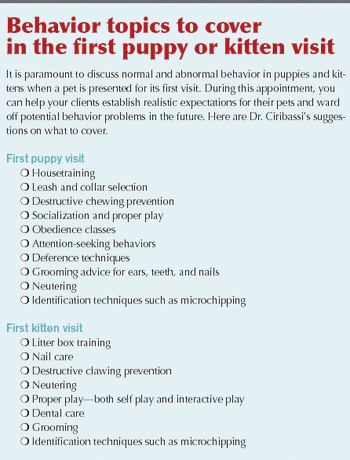
Misbehaving is the most dangerous thing a companion animal can do.
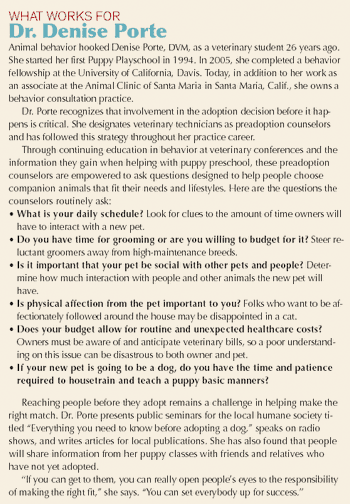
Although it is obvious to veterinarians that a Border collie and a 96-year-old woman likely make a poor pet-owner match, it may not be obvious to a potential owner who has never been around Border collies. Indeed, one reason healthy animals wind up in shelters, says Gail Golab, PhD, DVM, American Veterinary Medical Association (AVMA) interim director for animal welfare, is because people "acquire a pet with an expectation the pet doesn't fulfill."

Have your clients fill out this form if they indicate that they think their pet has a behavior problem.

Medicating a headstrong cat can be a challenge. However, compounding pharmacies have made the task easier by preparing many medications as flavored liquids, chewable treats, or transdermal gels.

Fort Collins, Colo. - 7/19/2007 - There may be a link between an increase in emergency room visits for dogs and cats and lunar cycle days when the moon is near or at its fullest, according to a study by colleagues at Colorado State University's (CSU) College of Veterinary Medicine and Biomedical Sciences.

Dr. Hunthausen explains how to help dog owners deal with this frustrating situation.

Dr. Hunthausen explains why you should consider adding a benzodiazepine during the initial treatment of canine separation anxiety.

Dr. Hunthausen demonstrates how to teach a puppy to sit and come on command.

Diagnosing food-related aggression in dogs is fairly straightforward--the history reveals that a dog in possession or proximity of a food item directs a threat or harmful action toward another with the intent of backing that individual away from the food item.

A well-housetrained dog is a requirement for most pet owners. In fact, behavior problems are a common cause of relinquishment to animal shelters, and inappropriate elimination has been reported to make up 15% to 24% of the behavior problems seen in veterinary behavior clinics.

You can easily teach your dog to eliminate in an acceptable location by keeping a close eye, recognizing his signals, understanding his instincts, and rewarding his appropriate behavior.
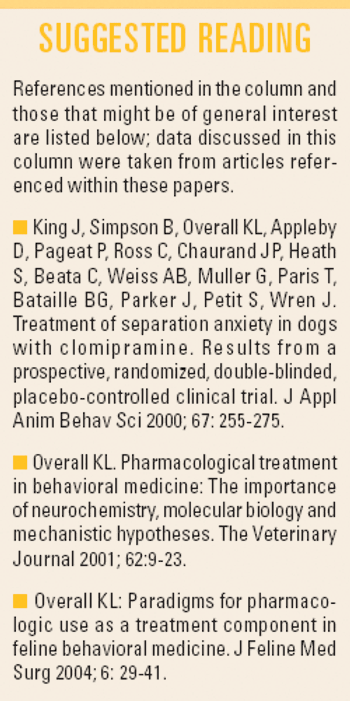
These steps teach the troubled pet that you are reliable and trustworthy...

If a pet rabbit frequently thumps, this indicates that the environment is too stimulating or threatening.

This column is the first in a series addressing the most-common questions that veterinarians ask me about behavioral medicine.

Rabbits naturally prefer to have a specific site for elimination, so you can easily train your rabbit to eliminate in a litter box.

Dr. Wayne Hunthausen offers his recommendations for making the first puppy visit a smooth one.
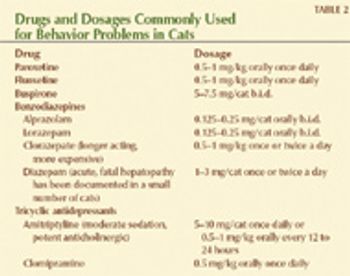
To help aggressive cats and the families that own them, veterinarians must rule out medical problems, take a complete history, make a sound diagnosis, and provide sensible advice.

Contrary to popular belief, cats are not asocial creatures.
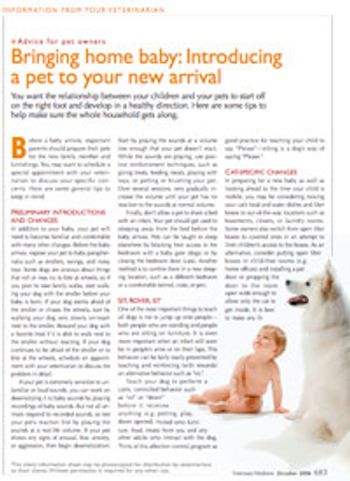
You want your clients' relationships between their children and their pets to start off on the right foot and develop in a healthy direction. Here are some tips to help make sure the whole household gets along.